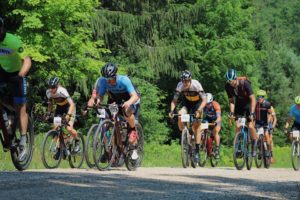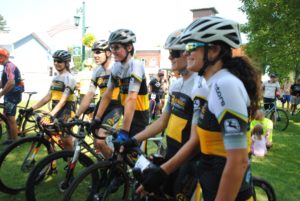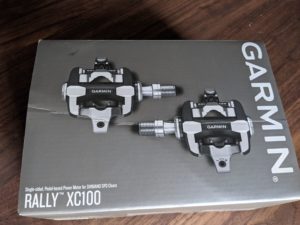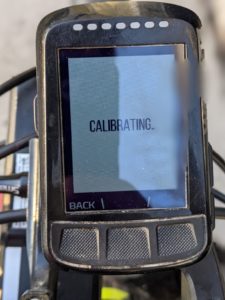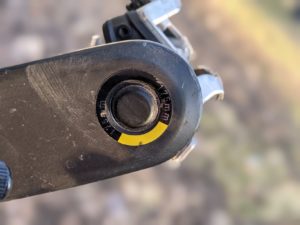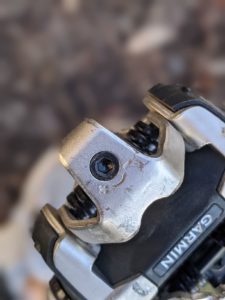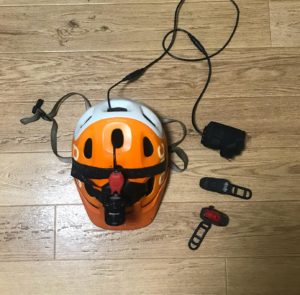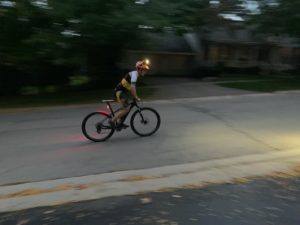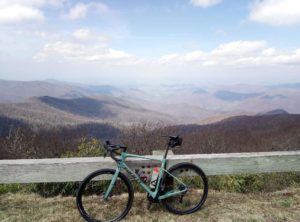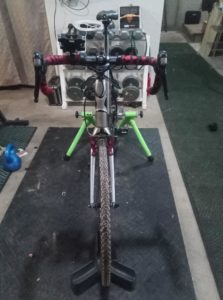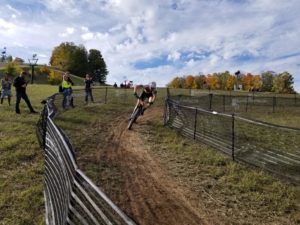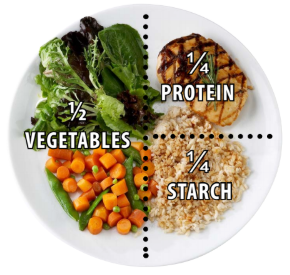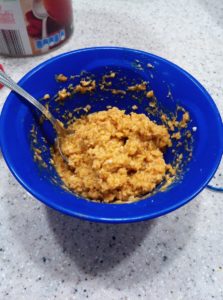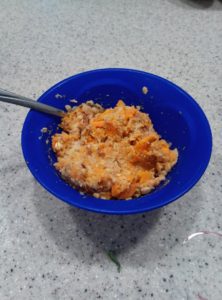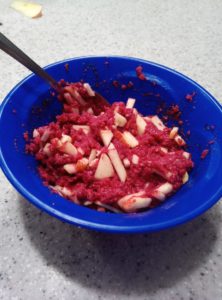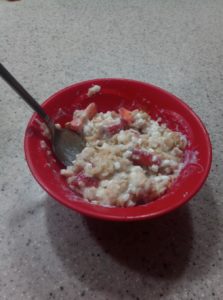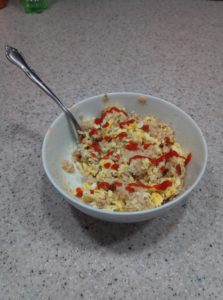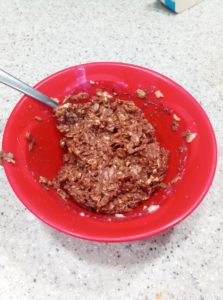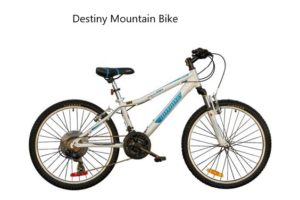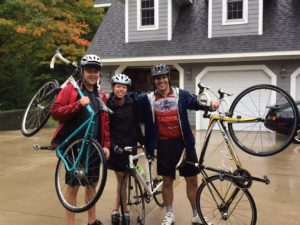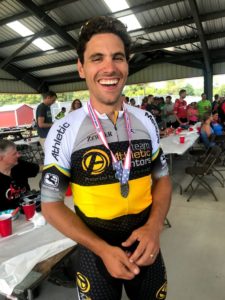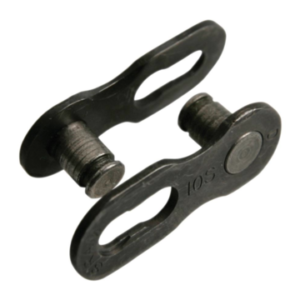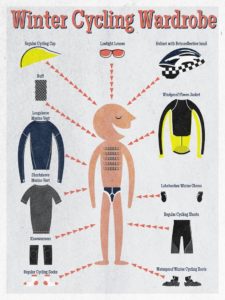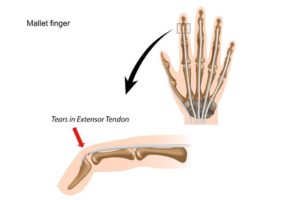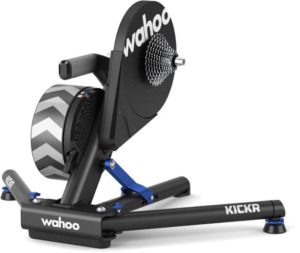By: Jared Dunham
Barry Roubaix is a uniquely Michigan festival of gravel that generally starts the season off. However, this year things were a little different. Due to rescheduling from COVID, we experienced the race in early October, just as the leaves began to change and Iceman prerides become a regular thing on weekends.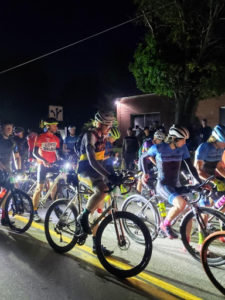
Barry has four distances to choose from, the 18-mile Chiller, 36-mile Thriller, 62-mile Killer, and 100-mile Psycho Killer. No matter the distance, Barry never shies away from a healthy serving of elevation on each route. However, the 100 miler has approx. 6,800ft of climbing and showcases the most remote two-track that Barry county has to offer. This was my first experience tackling the Psycho Killer, but after a year’s worth of long rides, I was confident in my abilities going into the event.
The morning of Barry had arrived, and I was indecisive on whether to wear a wind vest or only a jersey at the start line. On my warmup I opted for the jersey, additionally, I almost ran over a large raccoon. It was then 6:40AM, and the lights of about 243 riders could be seen on the streets of Hastings. If you know someone who is crazy enough to enjoy 100+ mile gravel rides, they were likely there on that October 10th morning.
While hilly, the beginning 35 miles remained tame, and were a prologue for the rest of the ride. Occasionally a hard effort was put in by riders at the front, but for the most part, a peloton of 50 or so remained together until we reached the first seasonal road. I didn’t get a chance to ride it, but I did walk through some of the portions of Two-Track and had an idea of what I was getting into.
Nearing the 35-mile mark, racers at the front of our group pushed the pace and I positioned myself in the top 10 leading into the first two-track. As predicted, we made a left onto Solomon Rd. and things went from Chiller to Psycho Killer. Everyone was riding/running up the sandy climbs and it went from a group ride to everyone for themselves at that point. A break of 5 riders occurred and I was 7th exiting this the first section of two-track. The next 10 miles or so were on and off seasonal road, and for a while I could still see the lead group off in the distance. Eventually, I caught up with Nicholas Stanko and we rode together in intervals. By intervals I mean he would get ahead on some sections, and I would catch up on others. The lead group eventually faded off into legend as we continued the ride.
Near Middleville, we were treated to 5 miles of ultra-smooth pavement, and only hit one red light while getting through town. At mile 47, Nick looked back and asked, “You think we can catch them?”. I, who was already having a hard time in his draft, replied, “I’m just going to see how long I can hang on,”. Not long after that, Tim Mitchell soloed up to us in aero position, setting a harder pace. I promptly fell off the duo, I had been pushing myself hard and knew that the last 18 miles were going to leave a mark. Looking back, there was no one as far as I could see. Consequently, I got back into a groove and rode solo. Mile 48, more seasonal road arrived, Tim and Nick were back in sight. Again, at certain portions of these roads, I would begin to catch up and in others, I would fall behind.
At mile 60, we hit the infamous Sager Rd. No, I’m not talking about the normal edition of Sager Rd. This is the Big Papa to the normal portion of Sager. More sand, more climbing, and more descending. At the end of the “road”, two huge, unavoidable mud puddles lay before me. I must thank Nick Dehaan for pointing out that you can run alongside the first puddle. I’m well-versed in drivetrain issues so I figured it was a better option to walk the first puddle and run through the second.
Returning to classic Barry gravel, I was now very much solo. At mile 65, I had to stop at the Otis Lake aid station. The plan was to bring enough water to not stop. However, one of my three water bottles shot off my bike frame on the first two-track, and the water bladder in backpack had questionable motives. By that I mean it was leaking onto my right leg the entire time. Keegan pointed out at the end of the race that it looked like I had either crashed or was having an allergic reaction (I had been drinking red Gatorade). Some of the kind volunteers topped me off with fluids and I also grabbed a few Clif Bloks shots. Exiting the aid station, Keegan Korienek and Scott Quiring caught me. We were then a trio, and with no seasonal road between us and the finish, it was full gas for the remaining 40 miles.
If I had to guess, I would say that it was about mile 70 when Benjamin Meer and Adam Hockley caught up to us. Unfortunately, not long after this, Adam had a flat rear tire and stopped for repairs, so we were then a group of four. With 30 miles to go, I was at the edge of my limits. On the turns, I had to push hard to stay with the group and when it came time to take a pull, my legs didn’t want to obey. The thought repeatedly crossed my mind that I should just let the group go and ride my own pace. However, while things seemed to be deteriorating, I affirmed that come hell or high water I would finish with the group.
With about 25 miles remaining, we found Nick Stanko, who informed us that there were 6 riders ahead. There were 5 cyclists in the group, someone would not be on the podium in a few hours. The following 20 miles were a lot more hills and as crazy as it might sound, I felt myself recovering a bit after 95 miles in the saddle.
Keegan, Scott, and I had a promise that no games would be played till the last 5 miles. We all kept to that promise.
3 miles to go: Ben made a small break on a flat section of gravel. Nick soon followed his wheel. Scott put in an effort to try and catch the pair. In the previous two miles, I felt cramps coming on and knew my legs were toast. I came around Scott to try and close the gap between us and the pair.
2 miles to go: Try as I might, I couldn’t bring them back and as we began descending the last gravel hill and onto the pavement, Scott came around me and I hopped on in his wheel. The order was then: Nick, Ben, Scott, Me, and Keegan. On pavement, we motored down a long descent to catch Nick and Ben. Scott was unable to close the gap, and the other two were just a few bike lengths ahead. I came around and Keegan was the one to finally seal the deal and close the gap. At that point we made our last right hand turn onto more pavement.
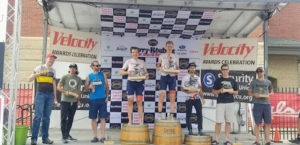 1 mile to go: I felt myself slipping from the group, someone from the Thriller rode up next to me saying, “Come on let’s get ’em big guy!”. That was all the motivation I needed.
1 mile to go: I felt myself slipping from the group, someone from the Thriller rode up next to me saying, “Come on let’s get ’em big guy!”. That was all the motivation I needed.
This was it. The culmination of 104 miles of Gravel, Two-Track, Pavement, Grit, and Some Luck. We were in the home stretch. The group was silent now and the only noises besides cheering spectators were bike chains running over gears and rubber on pavement. Off in the distance, the sound of music and the announcer slowly drew closer.
??? miles to go: I was riding in the drops behind Scott, at the tail end of the group, as the countdown to the final sprint ticked away. The order of the group was Nick, Ben, Keegan, Scott, and Myself. I Can’t remember who it was that started the sprint but when the dust had finally settled, the order was: Keegan, Nick, Ben, Scott, and Myself.
Not sure how it happened, but I had taken 10th place. Maybe because Scott had crossed the starting mat before me and I had then caught up to him, but was the last one over the finish line of our group. Either way, I was absolutely floored to be able to finish the ride the group.






